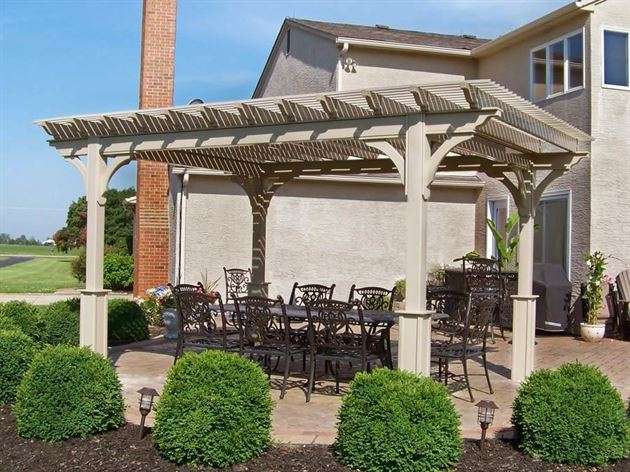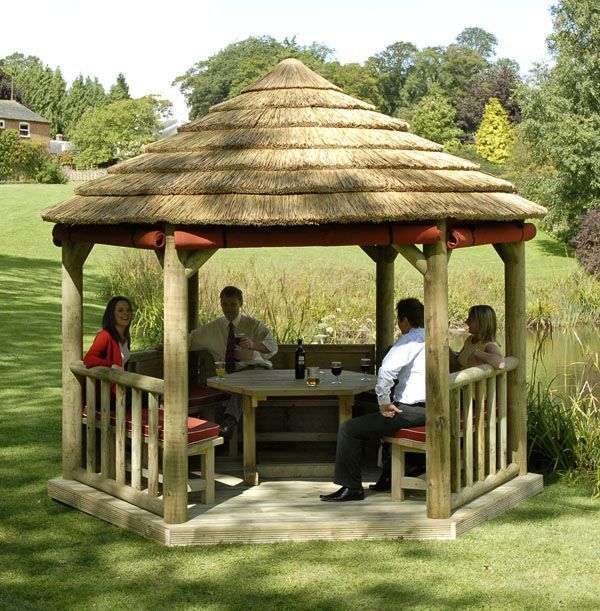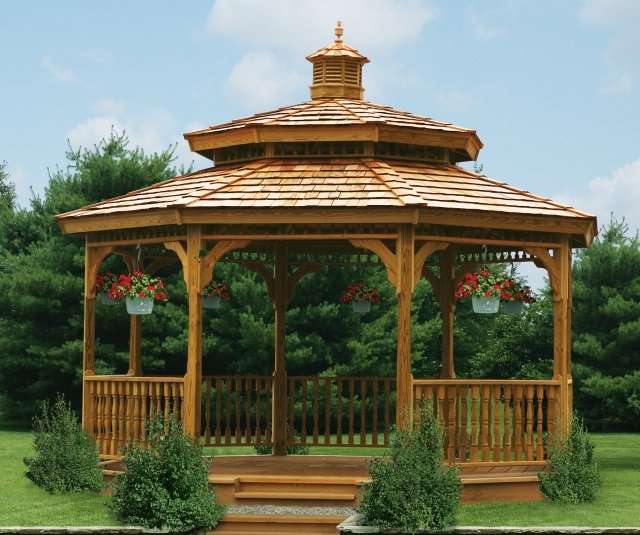Pergola Vs Gazebo: Whats The Difference
The biggest difference between a pergola and a gazebo is in the roof. A pergola has an open roof made of rafters, while a gazebo has a fully closed roof. A gazebo offers full shade and protection from the weather. A pergola allows the sun and the rain inside.
Are you tired of indoor living? You may want to consider building a permanent outdoor structure in your backyard where you can spend your summer days relaxing and letting go of your worries.
Pergolas and gazebos are becoming increasingly popular amongst homeowners and you too can jump on the trend!
But which structure is ultimately better for you? Pergola vs gazebo?
If you would like a shelter in the middle of your lawn that offers full shade and protection from the elements, opt for a gazebo. Conversely, if you would like to define a specific area in your backyard with an open structure, go for a pergola.
Theres a lot more you need to know! You can find all pergola and gazebo differences below!
Contents
A pergola is an open-style outdoor structure easily recognized by its lattice roof and open sides. It has vertical posts with cross beams and rafters across the top. Its appearance may be simple, but it creates a huge difference in ones backyard.
Since pergolas have a unique look to them, they are great for defining a space within the yard. They add visual interest to a garden and can look very romantic if you train grapevine or flowering vines to grow over the lattice.
Appearance
Common Uses For Pavilions
A pavilion has a lot of room underneath. A pavilion will hold and protect a much larger group of people than any of the other structures will. There are people who put full kitchens underneath their pavilion because the square footage of it is so large.
Pavilions are a bit more costly than the other three structures. However, on top of everything that a pavilion provides, it also will increase the value of your home.
Pros And Cons Of Pergolas
Pros:
- Pergolas are easy to build or assemble.
- They tend to be less expensive when compared to a gazebo.
- They give more visual structure and spacing to the yard.
- Depending on the quality and placement, a pergola can also add value to your space.
- They provide some measure of shade.
- There are a wide variety of materials to use in building a pergola.
- Pergolas sometimes offer more versatility in terms of design and aesthetic to the overall property.
Cons:
- Pergolas do not provide as much shade or protection as does a gazebo.
- They are often not as sturdy or fixed as a solid gazebo.
- Pergolas don’t ever come with a floor.
You May Like: How To Paint A Patio Umbrella
Arbor Vs Pergola Vs Gazebo
A beautiful outdoor space that you can call your own is one of the best additions you can bring to any home. Outdoor features such as arbors, pergolas and gazebos can all elevate a backyard and make it feel like your personal, private escape. But whats the difference between the three? Comparing an arbor vs. pergola vs. gazebo can help you decide.
If youre making over your backyard space and think that youd like to add one of these structures, you might be wondering what exactly is the difference between a pergola and a gazebo and where an arbor fits into all of it. While there are certainly similarities between a pergola vs. gazebo or arbor, there are more differences that separate them by form and function.
To help you decide whether you should install an arbor, pergola or gazebo, were sharing a little bit more about each of these outdoor structures so you can determine which one fits your needs and goals for your outdoor space.
How To Install A Pavilion

To install a pavilion immaculately, it is necessary to devise a step-by-step construction plan. First and foremost, invest in the best quality material you can afford. E.g., choose weather-resistant materials like pressure-treated lumber, pine, or cedar.
Take proper measurements beforehand and cut and assemble the components accordingly. To avoid the wood from splitting, screw pilot holes instead of drilling the screws directly.
Most pavilions can be anchored to a 4 thick concrete foundation with a 12 thick outer edge. If you are installing the pavilion in a place without a concrete base, dig the post holes for concrete footings. The structure will then be fastened to the concrete footers. The size of the footings depends on the size of the unit you purchased.
A simple garden pavilion can be installed by any person having basic carpentry knowledge. However, bigger pavilions like those in parks and vacation homes need to be installed by professionals.
Recommended Reading: How To Remove Mildew From Patio Furniture Cushions
How To Choose A Pavilion
A pavilion is a permanent structure made from metal, cement, or concrete. It offers various designs to choose from. Consider the one that suits your aesthetics.
Bow-top pavilion
This pavilion is used as an entryway to a property. It has a huge semi-circular shape that immediately catches the eye.
Veranda pavilion
A veranda pavilion is an a-frame-style pavilion with a thatched roof. It is commonly attached to the sides of a vacation house to enjoy the cool breeze.
Cottage pavilion
The cottage Pavilion resembles an ancient Chinese pavilion. They have a canopy roof that extends outwards and sides framed with gray stones.
Split-level pavilion
A split-level pavilion is made from timber, featuring an elevated floor that is framed by 4-6 posts. It can be installed in your backyard or garden to accentuate the landscape.
Dining pavilion
A dining pavilion has a flat roof and raised floor. This style is mostly used as an apartment balcony.
What Are The Main Differences Between Gazebos And Pergolas
When it comes to these two structures, there are three major differences:
Superior Gazebos and Pergolas at Great PricesIf you need assistance deciding which option is best for you, the experts at Superior Sheds can help. We design a wide variety of gazebos, pergolas, and sheds to help complete your perfect outdoor living space. Our experienced staff is always on hand to help you in designing a structure that fits your style, budget, and needs. To find more information about the body, roof, trim, or colors we carry, give us a call today at 1-877-439-7433.
You May Like: How To Clean Bird Poop Off Patio
How To Install An Arbor
One of the crucial steps when installing an arbor is to ensure that its legs are secured to the ground so that it doesnt blow over by strong winds or other unprecedented hazards.
Read also:10 Best above ground pools
It is convenient to use a post-hole digger to dig holes that are 2- 2 ½ ft. below the ground. Insert 2×4 inches treated pressure lumber into the hollow legs of the arbors. Pressure-treated lumber outlasts natural wood because of its moisture and mildew resisting properties. It is also denser than untreated wood.
Usually, two people are required for installing an arbor. Place the legs inside the holes and check the level, whether it is skewing or not. Based on your judgment, adjust the skew by putting the soil back in one hole and taking it out from the other one. Make sure to flatten the soil before you place the post again.
As you fill the holes after placing the post it is essential to pack the soil with a rod or a stick after adding each layer. If you compromise on this step, your arbor will settle and tilt with the passage of time.
Whats The Difference Between Pergola Vs Gazebo
Gazebos, unlike pergolas, have a closed roof. Most gazebos are raised off the ground and rounded, while pergolas are rectangular and connected to a hard ground surface like a patio.
Other outdoor structures similar to pergolas and gazebos include arbors and trellises, which are generally smaller and used differently.
You May Like: Antique Wrought Iron Outdoor Furniture
Patio Productions Luxury Outdoor Furniture Design
Patio Productions.com is a retailer of fine outdoor furniture. You order what you want online and have it shipped directly from our warehouse and straight to your front door, all free of charge. Were able to offer such low-prices because all items ship direct from warehouses across the country. This is how we eliminate costly stocking fees and pass the savings on to you! Hop over to our homepage to find the perfect outdoor set for your patio!
Common Uses For Gazebos
A gazebo provides more protection compared to an arbor or pergola. Gazebos often have mosquito screening for protection whereas the other structures do not normally provide such a barrier to pesky bugs.
Gazebos are usually found by themselves outside in a park or in a backyard setting, compared to a pergola or pavilion that is normally attached to the side of a house.
You May Like: How To Install Ceiling Fan On Aluminum Patio
What Is The Purpose Of A Pergola
Unlike gazebos, pergolas are open air structures with open roofs supported by columns or posts. The main function of a pergola is to provide afternoon relief from the harsh summer sun. Today, many homeowners build pergolas to add architectural interest by breaking up large areas and adding a vertical feature to the landscape.
Gazebo Vs Pergola: Which Is The Best Choice For Your Outdoor Space

So, youve gathered the perfect furniture for your outdoor space, and all that is missing now is some shade under which you can cool off on a hot summer day. If you dont have a deck, alfresco or a tall tree, the best way to add some shade is to use a gazebo or a pergola. But which one is best for your outdoor space? Lets take a look at how both of these structures differ.
You May Like: Clean Mold Off Concrete Patio
What Is A Gazebo
Ever wonder whether you should choose a gazebo or pergola but arent sure exactly what the differences are between the two? A gazebo is considered the most defined of these outdoor structures. Gazebos are freestanding, usually with an octagonal shape that features a pitched roof with a cupola at the very top. A gazebo is supported by multiple columns around the entire structure except for the entryway.
Gazebos usually have railings around the sides of the structure, and some even feature screening to offer more protection from outdoor conditions. Traditionally, gazebos also include built-in benches for seating.
While traditional gazebos were made of wood, today, you can find them made from several materials, like aluminum, vinyl and wicker. As for roofing, its typically made of shingles or wood.
Whats The Difference Between Canopy Pergola And Gazebo
To answer this question properly, we must first define what, exactly, a canopy, pergola, and gazebo are. From that, we can then define the specific differences that they consist of and what sets one apart from the other. That way, you can then decide which one is right for you.
This website is supported by readers. As an Amazon Associate we earn from qualifying purchases.
Read Also: How To Remove Mold From Concrete Patio
What Is An Arbor And How Is It Different
As an architectural element, arbores are typically open structures that consist of two lattice wall joined by an arched or squared top. The side walls sport a design very similar to a trellis, although with a looser lattice framework. Overall, however, an arbor must have a roof designed to support vines and climbing plants. Sometimes, it includes an actual gate where it makes sense to have one.
An arbor is typically designed to be an entryway or passageway covered with climbing foliage. As such, many homeowners use the structure to define the entryway into parts of the garden. It is also used to divide and define two distinct areas in your garden. Some landscaping designs use an arbor to protect garden beds from being trampled.
Owing to the modern interpretation of what an arbor is, many homeowners are adding seating facilities in the tunnel of their arbors. In this use of an arbor, the structure is used to provide a vegetated shading area. Others still replace the lattice framework roof with a solid roof for improved weather protection.
Undoubtedly, however, this feature adds an element of character and mystic to any backyard. Moreover, given its versatility, you can incorporate an arbor into your landscape design, even when you have limited space.
How To Choose An Arbor
Arbors are built from rough-sawn cedar or pressure-treated lumber that will hold against the weather, resist rot and repel water. Other materials like vinyl and metals are also used to construct an arbor. They require low maintenance and give a classic look.
Consider following arbor styles when looking to install one at your home.
Gabled arbor
A gabled arbor like the gabled pergola has a triangular arch with a slatted roof and sides to hang flowers and vines. The triangular roof is visible through the plants and displays a crisp look. It is often found in many garden sites.
Formal arbor
This particular arbor has a rectangular shape and flute columns. It gives more of a contemporary look and is a good choice for an entryway towards a fountain.
Arched arbor
Arched arbors are somewhat similar to gabled arbors. However, unlike the latters triangular construction, the arched arbors have an oval shape. These arbors have ladders rung grids on the sides for the plants to climb.
Moon gate arbor
Moon gate arbors, as the name suggests, resemble a half-moon. These arbors have a semi-circle shape. They are used in large properties owing to their size that ranges from 6-8 feet across. Moon gate arbors originated in Ancient China to symbolize a moon rising from the landscape. The slatted sides of the arbor are adorned with climbing plants. However, the structure itself plays a starring role of a sculpture instead of just being plant support.
Bench arbor
Recommended Reading: How To Make A Flagstone Patio With Grass
What Is A Pagoda
Whereas gazebos and pergolas have their origins in structures that were specifically designed and engineered for outdoor activities, backyard pagodas are inspired by the ornate, and often towering, multi-level structures found throughout South and East Asia. Pagodas have served as temples, places of worship, and spiritual sites for many centuries and are particularly associated with the Hindu and Buddhist religions.
The most common footprint shapes of pagodas are square, with some having hexagonal-shaped bases. On occasion, pagodas can also be round. The classic pagoda structure is the stacking of similarly shaped stories, with each upper level being proportionally smaller than the one below. Another signature characteristic of pagodas is the distinct rooflines of each story, with curved eaves sloping outward and upward.
As far as backyard pagodas go, they are usually limited to a single story for practical purposes and feature a solid, fixed roof supported by posts or columns. In this sense, they are structurally similar to gazebos in that they are essentially standing roofs with no walls. The distinctive design touches are what truly distinguish backyard pagodas from other outdoor structures.
Functional Comparison Of Gazebos Pergolas And Pagodas
From a functional perspective, gazebos, pergolas, and pagodas are comparable in some respects and quite different in others. While the charm and beauty of many outdoor structures cannot be denied, it is their functionality that makes them worthwhile investments for home and property owners.
When it comes to purpose and function, there are several categories worth considering, with each one alone worthy enough to heavily influence the decision as to which structure is best suited for a particular location. Here is how gazebos, pergolas, and pagodas stack up against each other:
Recommended Reading: How To Remove And Install Sliding Patio Door
What Is The Difference Between A Pergola An Arbor A Trellis And A Gazebo
When planning to spruce up your backyard, you first need to understand the various landscaping features and options available. After all, you cannot design an eye-catching landscape if you do not know what is possible. To this end, you ought to understand the various decorative architectural features used in landscaping and how they affect your landscaping design.
While the terms are often-times used interchangeably, pergolas, arbors, and trellises, and gazebos are different in design and purpose. Whats more confusing is their immense similarities in appearance. Do an image search of these terms, and you might end more confused than before. The architectural elements borrow a lot from each other on the design front, making them appear quite similar. You might choose a landscaping design that incorporates one or several of these structures.
With that in mind, you need to ensure that you understand the design of all these landscaping features. A proper understanding will help you create a relaxing, beautiful, charming, and even functional space in your backyard.
Herein, we will explore the difference between pergolas, arbors, and trellises, and gazebos to help you understand these options. Crucially, I will help you gain a better understanding of how these features are used and their impact on your landscape.
Which One Is Right For You

Determining whether a pergola or gazebo is the right fit for your outdoor space can be a difficult task. Here are a few questions to ask to help you decide:
Are you thinking about building a pergola or gazebo? We offer professional work and quality services. Get a free estimate today!
Read Also: How To Keep Birds Off String Lights